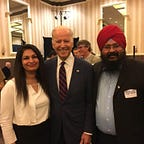We will not be electing only a president this November, BUT a livable planet
As many observers have noted, the human and economic toll from the COVID-19 pandemic outbreak is unprecedented in our lifetimes. The disease spares some and ravages others and will not stop until we find a solution in the form of a vaccine and effective treatments.
One of the first symptoms health professionals look for in a potentially COVID-infected patient is fever; the abnormal warming of the body tells us something is wrong.
There is an unsettling parallel in rising earth temperature, popularly referred to as “global warming.” Scientists, experts, and activists who know and care about climate change are aware of how seriously this planet is ailing. They predict its illness will grow in just a few years to cataclysmic and irreversible levels. The rest of us are ignoring its symptoms: increasing atmospheric temperatures, superstorms, droughts, tsunamis, floods, degraded soils, rising sea levels, and more. They tell us that the earth is sick and does not have much more time.
If the disease goes unchecked, it will metastasize into global conflict and human tragedy, which will cause even more environmental damage in a devastating cycle of destruction.
I am a Sikh, and most of the world’s 28 million Sikhs live in India’s Punjab region, where I was born and raised. As in other parts of the world, water scarcity and distribution comprise an existential issue in this predominately agricultural state. Drought is a constant reality. In a sad irony, efforts to more effectively manage scarce water resources through more modern farming techniques and seed varieties have caused increased carbon emissions, which exacerbate global warming and lead to more drought in dry regions.
However, the crisis is not isolated to India. Man’s unbridled pursuit of convenience, wealth and territory, often fueled by misguided cultural and religious differences, have contributed to catastrophes around the world. Many of us have witnessed the evidence for ourselves.
My former teacher, Tilak Raj Arora, a climber, mountaineer and environmentalist from his high school days and currently working for YMCA in Halifax, Nova Scotia, told me that he remembers seeing the results of Saddam Hussein’s order to burn the Kuwaiti oil fields thirty years ago.
“I could see the soot from there on Himalayan glaciers,” he said. “It trapped the heat from the sun, causing melting.”
The scourge of natural resources exploitation and pollution is across countries and continents, including many I have visited. Australia’s Great Barrier Reef is highly vulnerable. In the past three decades, it has lost half its coral cover, pollution has caused outbreaks of destructive starfish populations, and global warming has produced horrific coral bleaching.
Even in Morocco, a relatively developed African country, the effects of overgrazing and desertification are visible. South American deforestation, along with landslides and urban development, threaten Machu Picchu in Peru. Intense rainfall, heatwaves, and receding Alpine glaciers illustrate Italy’s climate woes. Because of coastal erosion, Norfolk in the U.K. is sliding into the sea, and other towns like York, Leeds, and Somerset are experiencing frequent flooding. The escalating violent and devastating weather and climate-related events in our own country are familiar to us all.
The only hope for mitigating the injuries from our environmental virus is a firm, courageous, innovative, and scientifically grounded national commitment. That starts with leadership dedicated to prioritizing solutions.
“We have run out of time to build new things in old ways,” Rob Jackson of Stanford University told Justin Worland of Time magazine.
We have seen the current administration’s retrograde position on just about everything, including climate change. Look no further than the withdrawal of the U.S. from the Paris Agreement to reduce greenhouse gases.
Many of us are praying for a new administration capable of healing our pandemic, economic, cultural, and environmental illnesses. Some see Joe Biden’s selection of Kamala Harris for vice-president as a major step in that direction. As a presidential candidate, her climate plan put the environmental justice front and center. This month, she and Rep. Alexandria Ocasio-Cortez introduced the Climate Equity Act in Congress. The act would set up a new Office of Climate and Environmental Justice Accountability within the Office of Management and Budget.
Unsurprisingly, women are in the forefront of these changes. Traditionally they are the healers, the ones we turn to when we are in pain, the ones we seek out for solutions, protection, and comfort.
As women continue to assume more positions of leadership, they may offer new points of view that can lead us back from the brink of irreparable disaster.
As my friend Arora said, women “suffer the most and worry the most about what this climate change will do to their homes and their children.”
Therefore, he asserts, “Only women can save us.”
